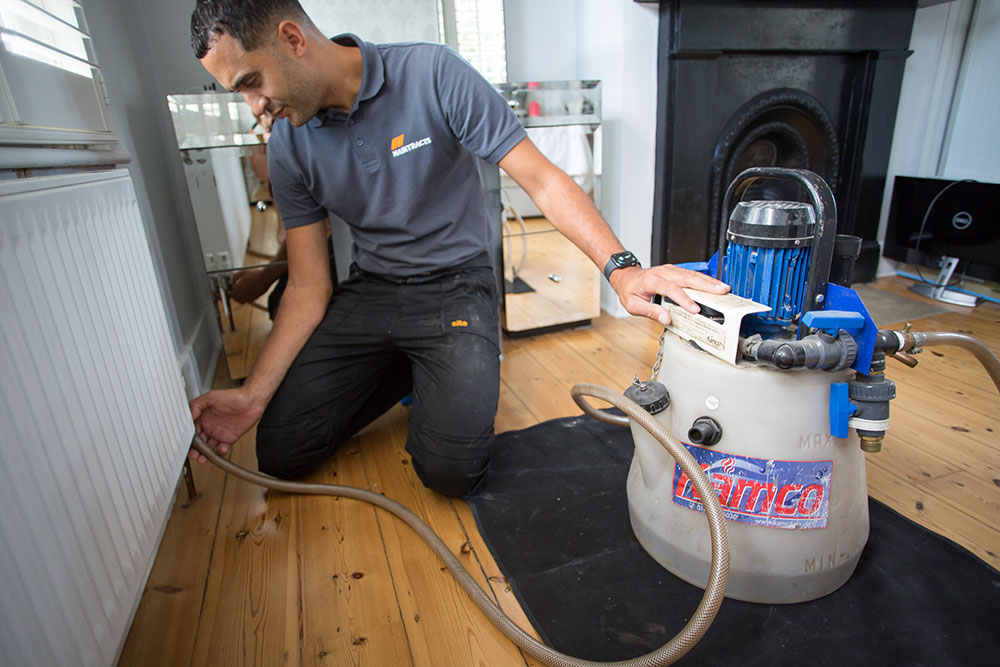Feeling the chill of inefficiency creeping through your home’s heating system? You’re not alone. As the seasons shift and temperatures drop, the reliability of our heating systems becomes paramount. Enter the powerflush – the unsung hero of home comfort restoration. But just how long does this transformative process take? In this blog, we unveil some of the key factors influencing the duration of a central heating power flush. We’ve also included some key insights to ensure your home stays warm and cosy all winter long.
The first thing to clarify is that when we refer to powerflushing a central heating system, we are referring to a comprehensive and intensive cleaning process that involves using specialised equipment to forcibly remove accumulated sludge, rust, and debris from the system’s pipes and radiators. Unlike chemical flushing or manual flushing, which may be less thorough, powerflushing utilises high-pressure water circulation to dislodge and flush out contaminants effectively. This process is typically recommended for heavily contaminated systems experiencing circulation issues or reduced efficiency, aiming to restore optimal performance and prolong the lifespan of the heating system.
Our heating engineers are often asked about the distinctions between chemical flushing, manual flushing, and powerflushing. The primary differences among them are found in their cleaning methods and the level of intensity applied to cleanse central heating systems. Chemical flushing involves using expert cleaning agents to dissolve sludge and debris, while manual flushing requires physically draining and flushing out the system with a hose, and as we’ve already covered, powerflushing is high pressure method.
Your choice of system flush will mainly depend on the system’s condition, with powerflushing being the most intensive and effective method for severe contamination or circulation issues. A qualified professional such as the team at Happy Dog Plumbing & Heating can determine the best approach for maintaining optimal performance in your home’s heating system.
How Long Does A Powerflush Take?
Our heating engineers usually dedicate an entire day or more to power flushing a central heating system at a property. This extended timeframe allows ample opportunity to complete the job thoroughly and safely, ensuring optimal results.
How Much Does A Powerflush Cost?
Usually, the cost of a powerflush for a domestic heating system ranges from £900 to £2000, excluding VAT. The final price depends on factors such as the type of installation and the number of radiators involved.
Factors Which Can Influence The Duration Of A Powerflush
Several factors can influence how long a powerflush can take:
Size Of The Heating System
Larger heating systems with more radiators, pipework, and components will typically take longer to flush thoroughly.
Level Of Contamination
The extent of sludge, rust, and debris buildup within the system can impact the time needed to flush it out completely. Heavily contaminated systems may require multiple passes or longer flushing periods to achieve optimal results.
Complexity Of The System
Systems with intricate pipework layouts, multiple zones, or hard-to-reach components may require more time and effort to flush effectively.
Type Of Heating System And The Condition Of The System
Different types of heating systems, such as traditional boiler systems, combi boilers, or underfloor heating systems, may have varying levels of complexity and require different flushing techniques, which can affect the duration of the process.
We possess the capability to perform powerflushing on all types of heating systems. However, our approach is tailored to match the specific characteristics and age of your system. For instance, in the case of older, non-pressurised systems with antiquated pipework, we exercise caution by refraining from subjecting them to high-pressure water, which could potentially lead to leaks below the floor if connections or pipes are compromised. In such scenarios, we opt for a manual flush method, either without the use of machinery or employing Thoroughflush equipment that operates via mains water pressure.
Furthermore, we strongly advise the installation of a magnetic filter to effectively collect and trap any magnetic materials present. Iron oxide, a by-product of water interacting with steel and copper components within the system, tends to accumulate as sludge deposits, posing a risk of clogging and damaging the system and its associated components. Moreover, it adversely impacts the system’s efficiency and longevity.
During both manual and machine-powered flushing processes, the central heating system undergoes treatment with specialised chemicals to facilitate the cleansing procedure. An efficient powerflush is designed to eliminate over 90% of the iron oxide deposits that have accumulated within the heating system. To enhance the effectiveness of the process, we employ techniques such as utilising a rubber mallet or an SDS drill with a special attachment to agitate the deposits within the radiators.
Accessibility
Easy access to radiators, valves, and other system components can streamline the flushing process, while limited accessibility may require more time for manoeuvring and accessing each part of the system.
Efficiency Of Equipment And Tools
The quality and effectiveness of the powerflushing equipment and chemicals used can impact the efficiency of the flushing process. High-quality equipment may facilitate faster and more thorough flushing.
Skill And Experience Of The Heating Engineer
A skilled and experienced heating technician familiar with powerflushing techniques can work more efficiently, potentially reducing the time required to complete the process without compromising effectiveness. Luckily, all our heating engineers at Happy Dog are full qualified and experienced in powerflushing.
We always recommend consulting with a qualified professional to determine the specific requirements of the heating system and to determine an accurate estimate of the time needed for a powerflush. Book an engineer today, and we’ll do the rest!


